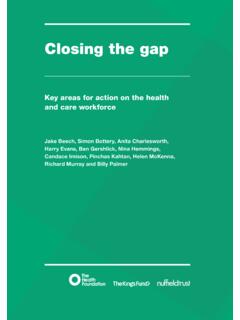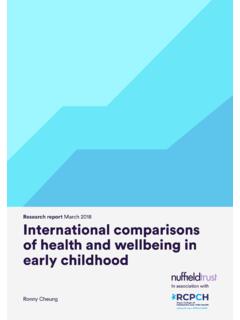Transcription of Integrating health and social care - nuffieldtrust.org.uk
1 Research report December 2021 Integrating health and social careA comparison of policy and progress across the four countries of the UKSarah Reed, Camille Oung, Jenny Davies, Mark Dayan, Sarah ScobieiiIntegrating health and social careAcknowledgementsSpecial thanks go to our reviewers for their thoughtful feedback and advice on earlier versions of this report: Professor Nicholas Mays, London School of Hygiene and Tropical Medicine; Dr David Steel, Senior Associate, Nuffield Trust; Professor Deirdre Heenan, Ulster University; Professor Keith Moultrie, Oxford Brookes University; Professor Derek Birrell, Ulster University; and Helen Buckingham, Nigel Edwards, Natasha Curry, Rowan Dennison and Paul Kirkup from the Nuffield Trust.
2 We would also like to thank the NHS Wales Informatics Service for providing data for the work uses data provided by patients and collected by the NHS as part of their care and support. Read more on our website about/corporate-policies#informationsecu rity-and-data. This report uses Hospital Episode Statistics (HES) data (year range 2011/12 to 2019/20). Copyright 2020, re-used with permission. A data-sharing agreement with NHS Digital (DARS-NIC-226261-M2T0Q) governed access to and use of HES data for this health and social careContentsKey points 2 Introduction 4 The health and social care system challenge across the four UK countries 8 How has the integration of health and social care evolved in each country?
3 16 Have integration policies had a measurable impact? 26 How has each country sought to implement integration policies? 39 Conclusions and key lessons 65 Appendix A: Thematic analysis and indicators considered 71 References 771234562 Integrating health and social care123456 Key points Each of the UK s four countries has a long-standing goal to integrate health and social care services, which has been a principle of successive major reforms by each government since devolution. Despite this, we found there is limited evidence that policies in any of the UK countries have made a difference to patients, or to how well services are integrated.
4 Across countries, there has been a persistent mismatch between some of the stated objectives of integration, and what better collaboration between health and social care can meaningfully achieve. Improving quality, efficiency, and population health have all been aims of integration, but are rooted in complex problems heavily constrained by broader government policies that influence the distribution of resources across health and social care, and ability for people to lead independent, healthy lives. The data to measure integration effectively are limited, particularly for Northern Ireland, and variable targets have been used. However, across England, Scotland and Wales, we found that satisfaction with care and support has been stable or falling, improvements in delayed transfers of care have not been sustained and the age-adjusted rate of emergency admissions to hospital has not fallen.
5 That over 20 years of reforms has translated into only modest improvements for patients across each country raises important questions about what integrated care can realistically deliver, how it s been implemented and at what scale, and why countries with significant contextual differences in their approach appear to have similar results. Policy-makers bringing forward new reforms need to learn from the fact that similar earlier initiatives often failed to demonstrate success. Without significant changes to the broader context in terms of system incentives and the distribution of resources, the latest reforms are unlikely to yield more favourable results. Part of the explanation may be each country s reliance on structural and organisational levers to drive integration, including joint governance arrangements and pooled finances.
6 While these have been applied and 3 Integrating health and social care123456designed differently across countries, they are similar in that they focus on how services are planned and financed in hopes that more coordinated service delivery will naturally follow. Yet in practice, they have been insufficient to address the culture, norms, systems and processes needed to support integrated ways of working and fundamentally change the way services operate. One of the key differences in how levers have been applied is the degree of statutory power or legal accountability integrated partnerships hold in each country. England is an outlier in that integrated care systems are not legal entities though proposals have been introduced that would place them on statutory footing.
7 The Scottish, Welsh and Northern Irish experience make clear, however, that having a legal duty to collaborate does not in of itself lead to effective collaboration, which also relies on having sufficient resources, incentives, regulatory and outcomes frameworks and consistent leadership and cultures across health and social care. Policymakers have also sought to reduce costs and improve efficiency by pooling health and social care budgets. There is limited evidence from any country that Integrating finances have led to cost savings especially in the short-term although they may help improve patient outcomes and experience. Nor have they encouraged more money to flow to social care and prevention in fact real terms funding to social care fell over the decade in all countries, except Northern Ireland.
8 Another common challenge has been the tendency for successive governments to establish new integrated partnerships without due regard for existing relationships and structures, and how different bodies will connect or evolve from what preceded it. This has made it difficult to measure impact over time, and for partnerships to fully embed and support change over the long-term. No matter how sensible the rationale for organisational restructuring may be, it takes time and headspace to deliver and can divert attention away from the core aim of improving service delivery for people. While performance management levers and incentives have been applied in some cases, such as for integration authorities in Scotland, these have had limited impact.
9 The performance management environment has been dominated by organisational-level targets, particularly those driving activity and performance in acute hospital health and social care124563 IntroductionThe integration of health and social care (see Box 1) has been a long-standing policy priority in each country of the UK, driven by the needs of a population that is living longer and with more long-term health conditions. The aims of integrated policy reform in the UK have largely been consistent: that is, to improve patient and service user experience, quality, and efficiency by reducing fragmentation within and across services and improving population health and wellbeing an ever-more pressing concern for a population whose needs are increasingly complex and inequalities stark.
10 The different paths taken across the UK to achieve these aims create a natural experiment from which to draw insight and learning on how integration can work most effectively, and how different approaches to implementation or emphasis within policy may have contributed to different outcomes for communities. However, the extent to which integration has been achieved in any of the UK countries and what benefit, if any, that has had for patients is open for the context of all UK countries continuing to develop their integration policy, in this report we examine the evidence for the impact of integration across the four countries, and compare the policies and approaches each country has trialled to deliver their goals.














